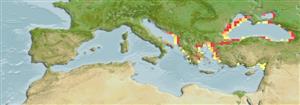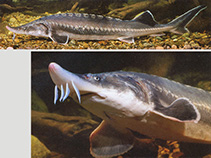Add your observation in Fish Watcher
| Native range | All suitable habitat | Point map | Year 2050 |

|
| This map was computer-generated and has not yet been reviewed. |
| Huso huso AquaMaps Data sources: GBIF OBIS |
Upload your photos and videos
Pictures | Stamps, coins, misc. | Google imageHuso huso
Picture by Hartl, A.
Pictures | Stamps, coins, misc. | Google imageHuso huso
Picture by Hartl, A.
Russian Federation country information
Common names:
Beluga, Kyrpy, Белуга
Occurrence: native
Salinity: freshwater
Abundance: | Ref:
Importance: | Ref:
Aquaculture: | Ref:
Regulations: | Ref:
Uses: no uses
Comments: Distributed in the Black Sea and the Sea of Azov, but less than in the Caspian Sea.The main spawning grouand is the Volga. All spawning grounds are inaccessible for fish due to the presence of power station dams (Ref. 26334). Reported from Don (Ref. 58293) and Kuban River drainages (Ref. 58296). This has been translocated to areas within the country for aquaculture and stocking in open waters however, it failed to establish populations in areas where it has been transplanted to (Ref. 45022). Also Ref 3561. EurRus
National Checklist:
Country Information: https://www.cia.gov/library/publications/resources/the-world-factbook/geos/rs.html
National Fisheries Authority:
Occurrences: Occurrences Point map
Main Ref: Reshetnikov, Y.S., N.G. Bogutskaya, E.D. Vasil'eva, E.A. Dorofeeva, A.M. Naseka, O.A. Popova, K.A. Savvaitova, V.G. Sideleva and L.I. Sokolov, 1997
National Database:
Occurrence: native
Salinity: freshwater
Abundance: | Ref:
Importance: | Ref:
Aquaculture: | Ref:
Regulations: | Ref:
Uses: no uses
Comments: Distributed in the Black Sea and the Sea of Azov, but less than in the Caspian Sea.The main spawning grouand is the Volga. All spawning grounds are inaccessible for fish due to the presence of power station dams (Ref. 26334). Reported from Don (Ref. 58293) and Kuban River drainages (Ref. 58296). This has been translocated to areas within the country for aquaculture and stocking in open waters however, it failed to establish populations in areas where it has been transplanted to (Ref. 45022). Also Ref 3561. EurRus
National Checklist:
Country Information: https://www.cia.gov/library/publications/resources/the-world-factbook/geos/rs.html
National Fisheries Authority:
Occurrences: Occurrences Point map
Main Ref: Reshetnikov, Y.S., N.G. Bogutskaya, E.D. Vasil'eva, E.A. Dorofeeva, A.M. Naseka, O.A. Popova, K.A. Savvaitova, V.G. Sideleva and L.I. Sokolov, 1997
National Database:
Common names from other countries
Classification / Names Tên thường gặp | Các synonym ( Các tên trùng) | Catalog of Fishes(Giống, Các loài) | ITIS | CoL | WoRMS | Cloffa
> Acipenseriformes (Sturgeons and paddlefishes) > Acipenseridae (Sturgeons) > Acipenserinae
Etymology: Huso: Latin, huso = swine (Ref. 45335).
More on author: Linnaeus.
Etymology: Huso: Latin, huso = swine (Ref. 45335).
More on author: Linnaeus.
Environment: milieu / climate zone / depth range / distribution range Sinh thái học
Biển; Nước ngọt; Thuộc về nước lợ; di cư biển sông (để đẻ trứng) (Ref. 51243); Mức độ sâu 70 - 180 m. Temperate; 10°C - 20°C (Ref. 2059); 57°N - 35°N, 13°E - 60°E
Sự phân bố Các nước | Các khu vực của FAO | Các hệ sinh thái | Những lần xuất hiện | Point map | Những chỉ dẫn | Faunafri
Eurasia: Caspian, Black, Azov and Adriatic Sea basins.
Extirpated from Adriatic Sea.
Length at first maturity / Bộ gần gũi / Khối lượng (Trọng lượng) / Age
Maturity: Lm ?, range 200 - ? cm
Max length : 800 cm TL con đực/không giới tính; (Ref. 59043); common length : 215 cm TL con đực/không giới tính; (Ref. 3397); Khối lượng cực đại được công bố: 3.2 t (Ref. 59043); Tuổi cực đại được báo cáo: 118 các năm (Ref. 47437)
Max length : 800 cm TL con đực/không giới tính; (Ref. 59043); common length : 215 cm TL con đực/không giới tính; (Ref. 3397); Khối lượng cực đại được công bố: 3.2 t (Ref. 59043); Tuổi cực đại được báo cáo: 118 các năm (Ref. 47437)
Short description Khóa để định loại | Hình thái học | Sinh trắc học
Các tia vây lưng cứng (tổng cộng) : 0; Các vây lưng mềm (tổng cộng) : 62 - 73; Tia cứng vây hậu môn: 0; Tia mềm vây hậu môn: 28 - 41. Snout moderate and pointed, turning slightly upward. Lower lip not continuous, interrupted at center. Barbels oval or flat, leaf-like posteriorly, reaching almost to mouth. Five rows of scutes, dorsal 11-14 (first one smallest), lateral 41-52 on each side, ventral 9-11 on each side. Back ash-grey or greenish, flanks lighter, belly white.
Pelagic at the sea, following its prey. Undertakes upriver migration to spawn. Juveniles occur in shallow riverine habitats during their first summer. Spawns in the main course of large and deep rivers with strong current and on stone or gravel bottom (Ref. 59043). Feeds mostly on sea fishes (Black Sea whiting, anchovies, flatfishes, gobies, fry of bottom-living fishes), also crustaceans, mollusks, mysids and amphipods. Fisheries are based almost entirely on the value of the caviar, but meat also is sold fresh, smoked and frozen; eaten broiled, boiled, fried and baked (Ref. 9988). Bester, a hybrid of female Huso huso and male sterlet Acipenser ruthenus, has been successfully cultivated for its high quality eggs (Ref. 9988). The largest sturgeon and largest European freshwater fish. In Guinness Book of Records as the most expensive fish (Ref. 6472). Threatened due to overfishing for meat at the sea and for caviar in estuaries. These threats will soon cause global extinction of the natural populations. Survival can only depend on stocking (Ref. 59043).
Life cycle and mating behavior Chín muồi sinh dục | Sự tái sinh sản | Đẻ trứng | Các trứng | Sự sinh sản | Ấu trùng
Enters rivers from March, usually April and May (also in autumn). Survives largely by artificial propagation. About 360,000-7,700,000 eggs per female. Females carry eggs only once every five to seven years (Ref. 9988).
Main reference
Upload your references | Các tài liệu tham khảo | Người điều phối | Người cộng tác
Kottelat, M. and J. Freyhof, 2007. Handbook of European freshwater fishes. Publications Kottelat, Cornol and Freyhof, Berlin. 646 pp. (Ref. 59043)
IUCN Red List Status (Ref. 130435: Version 2024-2)
Critically Endangered (CR) (A2bcd); Date assessed: 14 September 2019
Threat to humans
Harmless
Human uses
Các nghề cá: Tính thương mại; Nuôi trồng thủy sản: Tính thương mại
FAO(Aquaculture systems: Sản xuất; Các nghề cá: Sản xuất, species profile; publication : search) | FishSource | Biển chung quanh ta
Thêm thông tin
Trophic ecology
Các loại thức ăn
Thành phần thức ăn
Thành phần thức ăn
Food rations
Các động vật ăn mồi
Các loại thức ăn
Thành phần thức ăn
Thành phần thức ăn
Food rations
Các động vật ăn mồi
Population dynamics
Growth parameters
Max. ages / sizes
Length-weight rel.
Length-length rel.
Length-frequencies
Mass conversion
Bổ xung
Sự phong phú
Growth parameters
Max. ages / sizes
Length-weight rel.
Length-length rel.
Length-frequencies
Mass conversion
Bổ xung
Sự phong phú
Life cycle
Sự tái sinh sản
Chín muồi sinh dục
Sự sinh sản
Đẻ trứng
Spawning aggregations
Các trứng
Egg development
Ấu trùng
Sự biến động ấu trùng
Sự tái sinh sản
Chín muồi sinh dục
Sự sinh sản
Đẻ trứng
Spawning aggregations
Các trứng
Egg development
Ấu trùng
Sự biến động ấu trùng
Distribution
Các nước
Các khu vực của FAO
Các hệ sinh thái
Những lần xuất hiện
Những chỉ dẫn
BRUVS - Videos
Các nước
Các khu vực của FAO
Các hệ sinh thái
Những lần xuất hiện
Những chỉ dẫn
BRUVS - Videos
Anatomy
Vùng mang
Brain
Otolith
Vùng mang
Brain
Otolith
Physiology
Body composition
Nutrients
Thành phần ô-xy
Dạng bơi
Tốc độ bơi
Visual pigments
Fish sound
Diseases & Parasites
Toxicity (LC50s)
Body composition
Nutrients
Thành phần ô-xy
Dạng bơi
Tốc độ bơi
Visual pigments
Fish sound
Diseases & Parasites
Toxicity (LC50s)
Human related
Aquaculture systems
Các tổng quan nuôi trồng thủy sản
Các giống
Ciguatera cases
Stamps, coins, misc.
Aquaculture systems
Các tổng quan nuôi trồng thủy sản
Các giống
Ciguatera cases
Stamps, coins, misc.
Các công cụ
E-book | Hướng dẫn hiện trường | Khóa để định loại | Tần suất chiều dài Wizard | Công cụ của vòng đời | Bản đồ điểm | Classification Tree
| Catch-MSY |
Special reports
Download XML
Các nguồn internet
Alien/Invasive Species database | Aquatic Commons | BHL | Cloffa | BOLDSystems | Websites from users | Check FishWatcher | CISTI | Catalog of Fishes(Giống, Các loài) | DiscoverLife | ECOTOX | Faunafri | Fishtrace | GenBank(genome, nucleotide) | GloBI | GOBASE | | Google Books | Google Scholar | Google | IGFA World Record | MitoFish | Các cơ sở dữ liệu quốc gia | Otolith Atlas of Taiwan Fishes | PubMed | Reef Life Survey | Scirus | SeaLifeBase | Cây Đời sống | Wikipedia(Go, tìm) | World Records Freshwater Fishing | Tạp chí Zoological Record
Estimates based on models
Preferred temperature (Ref. 115969): 7.7 - 15.6, mean 9.1 (based on 19 cells).
Phylogenetic diversity index (Ref. 82804): PD50 = 0.7500 [Uniqueness, from 0.5 = low to 2.0 = high].
Bayesian length-weight: a=0.00427 (0.00257 - 0.00707), b=3.12 (2.98 - 3.26), in cm Total Length, based on LWR estimates for this species & (Sub)family-body (Ref. 93245).
Mức dinh dưỡng (Ref. 69278): 4.4 ±0.3 se; based on diet studies.
Thích nghi nhanh (Ref. 120179): Rất thấp, thời gian nhân đôi của chủng quần tối thiểu là hơn 14 năm (K=0.1; tm=13-22; tmax=118; Fec=360,000).
Fishing Vulnerability (Ref. 59153): Very high vulnerability (89 of 100).
Climate Vulnerability (Ref. 125649): Very high vulnerability (79 of 100).




